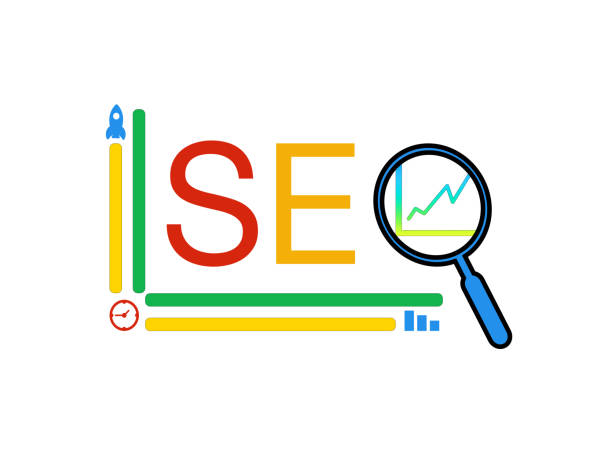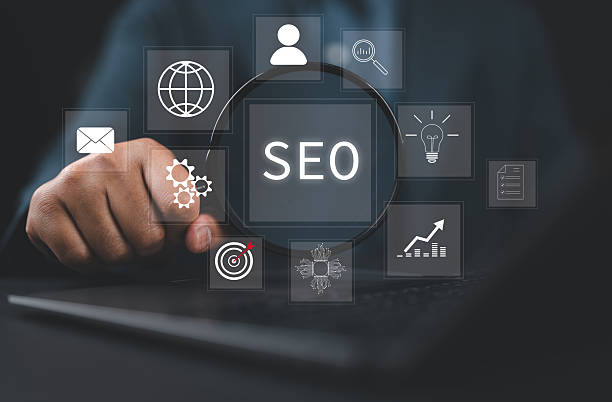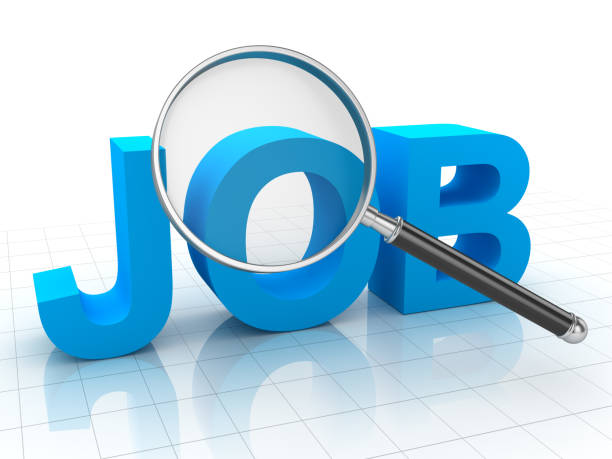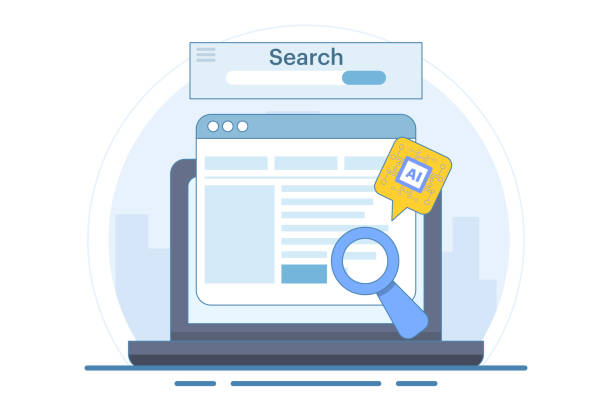Introduction to On-Page SEO and Its Importance

In today’s competitive internet world, a successful online presence is vital for any business.
One of the most important pillars of this success is #On_Page_SEO or On-Page SEO.
This part of search engine optimization includes all actions you take within your website to achieve a higher ranking in search results.
Do you know why optimizing your website for search engines is so important? The answer is simple: if users can’t find you, even the best content or product will be worthless.
On-page SEO helps search engines understand your content and recognize its relevance to user searches.
This process is not limited to keyword usage; it also encompasses multiple factors including title and meta description optimization, URL structure, image optimization, page load speed, and #user_experience (UX).
Without strong on-page SEO, your efforts in other SEO areas like off-page SEO or technical SEO will not yield results.
This part of SEO provides a solid foundation for visibility in #Google_ranking results.
In other words, on-page SEO is like preparing your home for visitors; the more organized, user-friendly, and understandable your home is, the greater your chances of attracting and retaining visitors.
This is not just a trick for search engines, but rather the creation of lasting value for your users.
When your content is well-organized and loads quickly, users will have a better experience, which is a key factor in increasing conversion rates and reducing bounce rates.
Investing time and energy in this vital aspect of website optimization is a smart and essential step that will bring long-term results.
Learning the principles of on-page SEO and implementing them correctly can significantly increase your website’s organic traffic and help you stand out in today’s competitive online space.
Are you worried your company’s old website is scaring new customers away? Rasaweb solves this problem with modern and efficient corporate website design.
✅ Increases your brand’s credibility.
✅ Helps attract targeted customers.
⚡ Contact Rasaweb for a free consultation!
Keywords and Their Place in On-Page SEO
![]()
After understanding the overall importance of on-page SEO, it’s time for one of its main pillars: keywords.
Proper keyword selection and placement are the cornerstone of any successful on-page SEO strategy.
Do you know how to find the right keywords for your content and how to naturally integrate them into your text? Keyword research goes beyond finding high-volume terms; you need to understand the user’s search intent.
Is the user looking for information (informational search), intending to buy (commercial search), or wanting to go to a specific website (navigational search)? Choosing targeted keywords relevant to your business and content helps search engines understand the true value of your page.
Tools like Google Keyword Planner, Ahrefs, Semrush, and KWFinder can be of great help in this journey.
These tools not only show search volume but also provide new ideas for related keywords and competitor analysis.
After finding primary and secondary keywords, it’s time to implement them in various on-page elements.
These elements include the Page Title (Title Tag), Meta Description, headings (H1, H2, H3), main body content, image file naming, and their alternative texts (Alt Text).
It’s important to avoid keyword stuffing, which is penalized by search engines.
Instead, distribute keywords naturally and legibly throughout the text.
Using synonyms and related keywords (LSI Keywords) also adds to the semantic richness of your content and helps search engines better understand the topic.
Optimizing these elements within the framework of on-page SEO not only sends positive signals to search engines but also improves user experience, as the content will be exactly what the user is looking for.
Ultimately, focusing on quality and semantic relevance will be more valuable than any number of keywords, helping you stay at the top of search results.
This is a fundamental principle in on-page SEO that should not be overlooked.
Content Optimization for On-Page SEO and User Experience

Content is king; this phrase has been heard many times in the SEO world and remains true.
But how do we produce content that is both optimized for search engines and engaging and useful for users? Content optimization for on-page SEO goes beyond merely incorporating keywords; it involves proper structuring, readability, and the value of the content for the audience.
Your content should be comprehensive and in-depth, addressing all aspects of the discussed topic.
For instance, if you’re writing about “best on-page SEO practices,” don’t just provide a few superficial tips; delve into details, give examples, and offer practical solutions.
Using logical headings (H1, H2, H3, etc.) not only helps search engines understand the information hierarchy but also makes the text easier to read for users.
Furthermore, content readability plays a very important role in on-page SEO and user experience.
Short sentences and concise paragraphs, the use of bulleted or numbered lists, and appropriate white space all contribute to attracting and retaining the audience.
Is your content written for the end-user or merely for the search engine? The answer should be both, with an emphasis on the user.
Search engines are becoming increasingly smarter, and their ability to identify high-quality and user-friendly content has grown.
Including multimedia elements such as images, videos, and infographics also adds to content appeal and increases user dwell time on the page, which is a positive signal for search engines.
Ultimately, good content is content that answers user questions, engages them, and provides added value.
This approach ensures that your efforts in on-page SEO translate into tangible results.
Comparison of Optimized vs. Non-Optimized Content Features for On-Page SEO
| Feature | Optimized Content for On-Page SEO | Non-Optimized Content for On-Page SEO |
|---|---|---|
| Keywords | Natural, relevant, and purposeful use | Stuffing (Keyword Stuffing), irrelevant |
| Content Structure | Logical headings (H1-H6), short paragraphs | Unstructured, long text blocks |
| Quality and Depth | Comprehensive, accurate, valuable, and responsive to user needs | Superficial, repetitive, no added value |
| Readability | Easy to read, use of lists and images | Difficult to read, continuous and tedious text |
| Purpose | Both user and search engine | Only search engine (with old approach) |
The Role of Internal Linking in Ranking Improvement

Internal linking is one of the most powerful but often overlooked aspects of on-page SEO.
This process involves creating links from one page on your website to another page within the same website.
But why is this so important? Internal links not only help users easily navigate your website and discover more relevant content, but they also help search engines understand your website’s structure and distribute “page value” or “Link Juice” across pages.
When a powerful and authoritative page links to other internal pages, it passes some of its authority to those pages, which can help improve their ranking in search results.
For an effective internal linking strategy, use descriptive and relevant anchor texts.
Instead of “Click Here,” use phrases like “Comprehensive On-Page SEO Guide,” which are clear to the user and send stronger semantic signals to search engines.
Your site’s hierarchical structure also plays an important role in internal linking.
Parent pages should link to child pages and vice versa, to create a logical and understandable network for search engine crawlers.
Additionally, identifying “orphan pages” that receive no links from other pages and adding internal links to them can significantly increase their visibility in search results.
Finally, internal linking is a low-cost and high-yield solution for strengthening on-page SEO and improving user experience, which should be addressed regularly and strategically.
This optimization aspect is an integral part of a comprehensive SEO approach and can make a big difference in your site’s overall performance.
Did you know that customers’ first impression of your company is your website? Boost your business’s credibility many times over with a powerful corporate website from Rasaweb!
✅ Custom and eye-catching design tailored to your brand
✅ Improved user experience and increased customer acquisition
⚡ Get a free consultation!
Technical Page Optimization for Search Engines

Alongside content and linking, the technical aspects of on-page SEO also play a vital role in determining your site’s ranking.
This part of optimization includes elements that directly affect the crawlability, indexability, and rendering of your pages by search engines.
One of the most important factors is page load speed.
Did you know that even a one-second delay in loading can significantly increase user bounce rate and negatively impact your ranking? Google and other search engines consider speed an important ranking factor because it improves the desired user experience.
Tools like Google PageSpeed Insights and GTmetrix can help you identify speed issues and provide solutions for improvement.
In addition to speed, responsive design is also of high importance.
Given the significant increase in mobile device usage for searching, ensuring that your website displays well on any screen size is essential.
Years ago, Google announced “Mobile-First Indexing” as its primary approach to indexing pages, meaning your site’s mobile version serves as the basis for ranking.
Schema Markup is another powerful technical tool that helps search engines better understand your content and display it as “Rich Snippets” in search results.
These rich results can significantly increase your click-through rate (CTR).
Checking Robots.txt and Sitemap.xml files is also essential to ensure proper crawler access to important pages of your site.
These technical measures form the backbone of a complete internal optimization and should not be overlooked.
Importance and Optimization of Images in On-Page SEO

Images play an important role in your website’s visual appeal and improving user experience, but did you know they can also significantly impact your on-page SEO? Image optimization is not just about reducing their size for load speed, but also ensuring that search engines can understand your visual content.
One of the most important steps in this regard is using appropriate Alt Text.
Alt Text provides a brief and accurate description of the image content, which is not only useful for visually impaired individuals but also helps search engines understand what your image is about and how it relates to the surrounding text.
Do you regularly set Alt Text for your website images?
In addition to Alt Text, image file naming is also important.
Instead of generic names like “image001.jpg,” use descriptive names relevant to your keywords, for example, “on-page-seo-techniques.jpg.”
This helps search engines better understand the image’s relevance to the page’s topic.
Image format should also be chosen carefully.
Modern formats like WebP can offer high quality with smaller file sizes, directly impacting page load speed.
Ensuring image compression without noticeable quality loss is another step that can improve your on-page SEO performance.
Also, using appropriate image dimensions (not much larger than needed) and implementing Lazy Loading, which loads images only when the user approaches them, can significantly increase your site’s speed.
Proper image optimization is a critical component of comprehensive on-page SEO that can help improve your ranking in Google image search results as well as web search results.
Examining Algorithms and Their Impact on On-Page SEO

The world of SEO is constantly changing, and these changes are mainly due to continuous updates of Google’s algorithms.
These updates directly affect how pages are ranked and, consequently, the approaches to on-page SEO.
Are you aware of the latest Google algorithm changes and how they can affect your on-page SEO strategy? For example, Core Web Vitals algorithms focus on factors such as load speed, interactivity, and visual stability of pages, all of which are considered part of technical SEO and user experience and are directly related to on-page SEO.
Understanding and adapting to these changes is essential to maintain or improve your website’s ranking.
Other algorithms like Panda (content quality), Penguin (low-quality links), and Hummingbird (semantic understanding of searches) also impact internal site optimization in various ways.
Google’s focus on user intent and content quality means that your content should not only include keywords but also comprehensively and accurately answer user questions and provide an enjoyable reading experience.
This analytical approach to algorithms helps us focus on fundamental, lasting, and effective on-page SEO principles instead of chasing tricks.
Following SEO industry news and studying analyses published by experts can keep you on the right track and prevent sudden ranking drops due to unawareness of changes.
A successful on-page SEO strategy is one that is flexible and can adapt to algorithmic changes.
Some Important Google Algorithms and Their Impact on On-Page SEO
| Algorithm Name | Year Introduced/Emphasized | Main Focus | Impact on On-Page SEO |
|---|---|---|---|
| Panda | 2011 | Content quality and originality | Penalizing low-quality, duplicate, or keyword-stuffed content |
| Hummingbird | 2013 | Semantic understanding of searches | Importance of related keywords (LSI) and comprehensive content |
| Mobilegeddon | 2015 | Mobile compatibility | Necessity of responsive design and mobile user experience |
| Core Updates | Ongoing | Overall site quality and authority (E-A-T) | Emphasis on expertise, authority, and trustworthiness of content |
| Core Web Vitals | 2021 | Page Experience | Importance of page load speed, interactivity, and visual stability |
Practical Tools for Analyzing and Improving On-Page SEO

To effectively manage and improve your website’s on-page SEO, you need to use appropriate tools.
These tools help you identify your website’s strengths and weaknesses and discover optimization opportunities.
Do you know which tools are best for examining and analyzing your on-page SEO? Google Search Console (GSC) is one of the most essential free tools, providing vital information about your site’s performance in Google Search, indexing issues, search traffic, and popular keywords.
This tool allows you to submit new URLs, check for crawl errors, and even identify security issues.
Another tool every SEO specialist should use is Google Analytics.
This tool allows you to track user behavior on your website, including dwell time on page, bounce rate, and navigation paths.
This data can provide valuable insights for improving user experience and, consequently, strengthening on-page SEO.
Alongside these Google tools, there are also specialized paid tools that offer more advanced capabilities.
For example, Ahrefs and Semrush are comprehensive tools that offer keyword research, competitor analysis, backlink checking, and site audit capabilities.
Their site audit feature can identify on-page SEO issues such as duplicate titles, missing meta descriptions, and broken links.
Tools like Screaming Frog are also very useful for deep website crawling and identifying technical on-page SEO issues.
Using a combination of these tools gives you a comprehensive view of your site’s on-page SEO status and helps you make data-driven decisions to improve your ranking.
Did you know that customers’ first impression of your company is your website? Boost your business’s credibility many times over with a powerful corporate website from Rasaweb!
✅ Custom and eye-catching design tailored to your brand
✅ Improved user experience and increased customer acquisition
⚡ Get a free consultation!
Challenges and Common Mistakes in On-Page SEO

Despite the high importance of on-page SEO, many websites and businesses unintentionally make mistakes that can render their efforts ineffective.
Are you aware of the most common challenges and errors you will face in the path of on-page optimization? One of the most common mistakes is keyword stuffing.
Hoping to achieve a better ranking, some webmasters unnaturally and repeatedly use keywords in the text, titles, and meta descriptions, which not only doesn’t help with ranking but can lead to penalties from Google.
Google is looking for high-quality, natural content, not just text filled with keywords.
Another error is ignoring user experience (UX).
Some SEO specialists focus solely on technical factors and keywords, neglecting the importance of user-friendly design, content readability, and site speed.
Remember that Google is increasingly focusing on user experience, and UX-related signals (such as high bounce rates or low dwell times) can directly impact your on-page SEO ranking.
Another problem is duplicate or thin content.
If you have multiple pages with similar or very little content on your site, this can lead to confusion for search engines and reduce your site’s credibility.
Proper use of Canonical Tags can help resolve duplicate content issues.
Also, neglecting image optimization, broken internal links, and illogical URL structure are other common mistakes.
To achieve successful on-page SEO, you must use a comprehensive approach that considers both technical aspects and content quality and user experience.
The Future of On-Page SEO and Upcoming Trends

On-page SEO, like other aspects of search engine optimization, is constantly evolving, with new trends emerging as technology advances and user behavior changes.
For your website to remain competitive in the future, it’s important to be aware of these trends.
One of the most important is Voice Search.
With the increasing use of voice assistants like Google Assistant and Siri, people have become more inclined towards conversational and question-based searches.
This means your keyword strategy should go beyond short, single-word keywords and focus on longer, question-based phrases (Long-tail Keywords and Questions) to be able to answer voice queries.
Is your website ready to answer user questions conversationally?
Artificial Intelligence (AI) and Machine Learning also play an increasing role in how search algorithms function.
Algorithms like Google’s BERT and MUM indicate that search engines have become smarter in understanding natural language and semantic complexities.
These developments emphasize for on-page SEO that content should not only be comprehensive and accurate but also answer complex questions and satisfy the user’s true intent.
Also, with the growth of video content and podcasts, optimizing these formats for on-page SEO (such as using transcripts, detailed descriptions, and appropriate tags) will become more important.
Finally, focusing on Inclusive User Experience (UX), Accessibility, and E-A-T (Expertise, Authoritativeness, Trustworthiness) will be more crucial than ever.
In the future, on-page SEO will transform from a collection of tricks into a philosophy: creating the best possible user experience, which naturally leads to visibility in search engines.
Frequently Asked Questions
And other services of Rasa Web Advertising Agency in the field of advertising
Smart Marketplace: An innovative platform for improving website traffic with engaging UI design.
Smart Brand Identity: A new service for enhancing campaign management through user experience customization.
Smart Advertising Campaign: A fast and efficient solution for improving SEO ranking by focusing on precise audience targeting.
Smart Sales Automation: Professional optimization for increasing click-through rates by optimizing key pages.
Smart Content Strategy: Designed for businesses seeking to attract customers through user experience customization.
And over hundreds of other services in internet advertising, advertising consultation, and organizational solutions
Internet Advertising | Advertising Strategy | Advertorial
Resources
Comprehensive Advanced On-page SEO Guide
Comprehensive On-page SEO Training
What is On-page SEO? Zero to Hundred Training
Comprehensive On-page SEO Text Training
Are you ready to transform your business in the digital world? Rasaweb Afarin Digital Marketing Agency, specializing in modern UI website design and comprehensive digital strategies, is your smart solution for growth and visibility.
📍 Tehran, Mirdamad Street, Next to Central Bank, Southern Kazeroun Alley, Ramin Alley No. 6



